Land Use Changes in the Southeastern United States: Quantitative Changes, Drivers, and Expected Environmental Impacts
Abstract
1. Introduction
2. Materials and Methods
2.1. Study Area
2.2. Synthesis of LULCC, Drivers, and Environmental Impacts from Published Articles in the SEUS
2.3. The Steps Used According to the PSALSAR Framework for Collecting and Synthesizing Articles
3. Analysis of Major Land Types Using Observed Quantitative Data
Procedure
- Land-type data were collected from excel files from the Economic Research Service (ERS.) USDA website, retrieved from https://www.ers.usda.gov/data-products/major-land-uses/major-land-uses/ (accessed on 8 December 2022). The data showed acreage data in the form of “millions of acres”.
- The data was then prepared and categorized into an excel file with five major land types:
- Cropland total,
- Forest land total,
- Grassland total,
- Special-use area total,
- Urban land total.
- 3
- The land type categories comprised twelve states in the SEUS from 1945–2012: Alabama, Arkansas, Florida, Georgia, Kentucky, Louisiana, Mississippi, North Carolina, South Carolina, Tennessee, Virginia, and West Virginia.
- 4
- The algebraic techniques of “Differencing” was applied to the data to get desired results for each time period (1949–2012). Data analysis by differencing involved subtracting acreage data of the former time period from the latter time period. This shows changes in acreage; the results were then plotted separately on graphs for each state [48,49].
- 5
- The algebraic differencing formula was used to calculate the changes between the acquisition dates of the two time periods, X1 and X2. Therefore, the formula used was [50]:
- 6.
- Line graphs were plotted for differencing results for each state for the analysis, these graphs include:
- Plots for the five land types showing the time period,
- Each time period is separated by five-year intervals (1949–2012),
- Comparative line graphs of all the states were carried out for the major land types, comparing the land types for differencing.
4. Results
4.1. Land-Type Data Analysis
- In general, some states had significant outliers for forest land and cropland, while the other land types were stable throughout the period.
- Urban land use total showed increased towards the end of the time period. The leading driver of this change has been attributed to rapid population growth in the SEUS [11].
- Grassland and special-use areas fluctuated based on how forest land and cropland acreage fluctuated.
- Special-use area total remained stable throughout the time period for most of the states and, in some cases, responded to urban land increases.
- Cropland acreage decreased after the year 2000 for most of the states.
- The population increased for most states; Florida and Georgia stand out with greater urban sprawls.
4.2. Statewide LULCC Analysis
4.3. Drivers Associated with Land Use Change in the SEUS
5. Discussion
5.1. Land Use Changes in Individual States
5.2. Quantitative Land Use Changes in the SEUS
5.3. Drivers Associated with Land Use Change in the SEUS
5.4. Assumptions, Limitations, Next Steps
6. Conclusions
Author Contributions
Funding
Data Availability Statement
Acknowledgments
Conflicts of Interest
References
- Brown, D.G.; Johnson, K.M.; Loveland, T.R.; Theobald, D.M. Rural Land-Use Trends in the Conterminous United States, 1950–2000. Ecol. Appl. 2005, 15, 1851–1863. [Google Scholar] [CrossRef]
- Drummond, M.A.; Stier, M.P.; Auch, R.F.; Taylor, J.L.; Griffith, G.E.; Riegle, J.L.; Hester, D.J.; Soulard, C.E.; McBeth, J.L. Assessing Landscape Change and Processes of Recurrence, Replacement, and Recovery in the Southeastern Coastal Plains, USA. Environ. Manag. 2015, 56, 1252–1271. [Google Scholar] [CrossRef]
- Milesi, C.; Elvidge, C.D.; Nemani, R.R.; Running, S.W. Assessing the Impact of Urban Land Development on Net Primary Productivity in the Southeastern United States. Remote Sens. Environ. 2003, 86, 401–410. [Google Scholar] [CrossRef]
- Drummond, M.A.; Loveland, T.R. Land-Use Pressure and a Transition to Forest-Cover Loss in the Eastern United States. BioScience 2010, 60, 286–298. [Google Scholar] [CrossRef]
- Franzluebbers, A.J. Integrated Crop-Livestock Systems in the Southeastern USA. Agron. J. 2007, 99, 361–372. [Google Scholar] [CrossRef]
- Fraisse, C.W.; Breuer, N.E.; Zierden, D.; Bellow, J.G.; Paz, J.; Cabrera, V.E.; Garcia y Garcia, A.; Ingram, K.T.; Hatch, U.; Hoogenboom, G.; et al. AgClimate: A Climate Forecast Information System for Agricultural Risk Management in the Southeastern USA. Comput. Electron. Agric. 2006, 53, 13–27. [Google Scholar] [CrossRef]
- Seager, R.; Tzanova, A.; Nakamura, J. Drought in the Southeastern United States: Causes, Variability over the Last Millennium, and the Potential for Future Hydroclimate Change. J. Clim. 2009, 22, 5021–5045. [Google Scholar] [CrossRef]
- Fall, S.; Coulibaly, K.M.; Quansah, J.E.; El Afandi, G.; Ankumah, R. Observed Daily Temperature Variability and Extremes over Southeastern USA (1978–2017). Climate 2021, 9, 110. [Google Scholar] [CrossRef]
- Anandhi, A.; Crandall, C.; Bentley, C. Hydrologic Characteristics of Streamflow in the Southeast Atlantic and Gulf Coast Hydrologic Region during 1939–2016 and Conceptual Map of Potential Impacts. Hydrology 2018, 5, 42. [Google Scholar] [CrossRef]
- Auch, R.F.; Napton, D.E.; Sayler, K.L.; Drummond, M.A.; Kambly, S.; Sorenson, D.G. The Southern Piedmont’s Continued Land-Use Evolution, 1973–2011. Southeast. Geogr. 2015, 55, 338–361. [Google Scholar] [CrossRef]
- Napton, D.E.; Auch, R.F.; Headley, R.; Taylor, J.L. Land Changes and Their Driving Forces in the Southeastern United States. Reg Env. Change 2010, 10, 37–53. [Google Scholar] [CrossRef]
- Findell, K.L.; Berg, A.; Gentine, P.; Krasting, J.P.; Lintner, B.R.; Malyshev, S.; Santanello, J.A.; Shevliakova, E. The Impact of Anthropogenic Land Use and Land Cover Change on Regional Climate Extremes. Nat Commun 2017, 8, 989. [Google Scholar] [CrossRef]
- Daniel, B.; Allison, B. Major Uses of Landin the United States; Economic Information Bulletin 263079; United States Department of Agriculture, Economic Research Service: Washington, DC, USA, 2012; 69p. [Google Scholar] [CrossRef]
- Knox, P.; Fuhrmann, C.; Konrad, C. Challenges and Opportunities for Southeast Agriculture in a Changing Climate: Perspectives from State Climatologists. Southeast. Geogr. 2014, 54, 118–136. [Google Scholar] [CrossRef]
- Asseng, S. Agriculture and Climate Change in the Southeast USA. In Climate of the Southeast United States: Variability, Change, Impacts, and Vulnerability; Ingram, K.T., Dow, K., Carter, L., Anderson, J., Eds.; NCA Regional Input Reports; Island Press/Center for Resource Economics: Washington, DC, USA, 2013; pp. 128–164. ISBN 978-1-61091-509-0. [Google Scholar]
- Pielke, R.A.; Pitman, A.; Niyogi, D.; Mahmood, R.; McAlpine, C.; Hossain, F.; Goldewijk, K.K.; Nair, U.; Betts, R.; Fall, S.; et al. Land Use/Land Cover Changes and Climate: Modeling Analysis and Observational Evidence: Land Use/Land Cover Changes and Climate: Modeling Analysis and Observational Evidence. WIREs Clim Change 2011, 2, 828–850. [Google Scholar] [CrossRef]
- Nagy, R.C.; Lockaby, B.G. Urbanization in the Southeastern United States: Socioeconomic Forces and Ecological Responses along an Urban-Rural Gradient. Urban Ecosyst. 2011, 14, 71–86. [Google Scholar] [CrossRef]
- O’Driscoll, M.; Clinton, S.; Jefferson, A.; Manda, A.; McMillan, S. Urbanization Effects on Watershed Hydrology and In-Stream Processes in the Southern United States. Water 2010, 2, 605–648. [Google Scholar] [CrossRef]
- Terando, A.J.; Costanza, J.; Belyea, C.; Dunn, R.R.; McKerrow, A.; Collazo, J.A. The Southern Megalopolis: Using the Past to Predict the Future of Urban Sprawl in the Southeast U.S. PLOS ONE 2014, 9, e102261. [Google Scholar] [CrossRef]
- Sun, X.; Crittenden, J.C.; Li, F.; Lu, Z.; Dou, X. Urban Expansion Simulation and the Spatio-Temporal Changes of Ecosystem Services, a Case Study in Atlanta Metropolitan Area, USA. Sci. Total Environ. 2018, 622–623, 974–987. [Google Scholar] [CrossRef]
- Zhang, C.; Tian, H.; Chen, G.; Chappelka, A.; Xu, X.; Ren, W.; Hui, D.; Liu, M.; Lu, C.; Pan, S.; et al. Impacts of Urbanization on Carbon Balance in Terrestrial Ecosystems of the Southern United States. Environ. Pollut. 2012, 164, 89–101. [Google Scholar] [CrossRef]
- Delphin, S.; Escobedo, F.J.; Abd-Elrahman, A.; Cropper, W.P. Urbanization as a Land Use Change Driver of Forest Ecosystem Services. Land Use Policy 2016, 54, 188–199. [Google Scholar] [CrossRef]
- Homer, C.; Dewitz, J.; Jin, S.; Xian, G.; Costello, C.; Danielson, P.; Gass, L.; Funk, M.; Wickham, J.; Stehman, S.; et al. Conterminous United States Land Cover Change Patterns 2001–2016 from the 2016 National Land Cover Database. ISPRS J. Photogramm. Remote Sens. 2020, 162, 184–199. [Google Scholar] [CrossRef]
- Yang, L.; Jin, S.; Danielson, P.; Homer, C.; Gass, L.; Bender, S.M.; Case, A.; Costello, C.; Dewitz, J.; Fry, J.; et al. A New Generation of the United States National Land Cover Database: Requirements, Research Priorities, Design, and Implementation Strategies. ISPRS J. Photogramm. Remote Sens. 2018, 146, 108–123. [Google Scholar] [CrossRef]
- Loveland, T.R.; Sohl, T.L.; Stehman, S.V.; Gallant, A.L.; Sayler, K.L.; Napton, D.E. A Strategy for Estimating the Rates of Recent United States Land-Cover Changes. Photogramm. Eng. Remote Sens. 2002, 68, 1091–1099. [Google Scholar]
- Griffith, J.A.; Stehman, S.V.; Loveland, T.R. Landscape Trends in Mid-Atlantic and Southeastern United States Ecoregions. Environ. Manag. 2003, 32, 572–588. [Google Scholar] [CrossRef]
- Gallant, A.L.; Loveland, T.R.; Sohl, T.L.; Napton, D.E. Using an Ecoregion Framework to Analyze Land-Cover and Land-Use Dynamics. Environ. Manag. 2004, 34, S89–S110. [Google Scholar] [CrossRef]
- Rosa, I.M.D. Monitoring and Projecting Land Use and Land Cover Change at Multiple Spatial Scales. Environ. Assess. 2020, 68–79. [Google Scholar]
- Meyfroidt, P.; Roy Chowdhury, R.; de Bremond, A.; Ellis, E.C.; Erb, K.-H.; Filatova, T.; Garrett, R.D.; Grove, J.M.; Heinimann, A.; Kuemmerle, T.; et al. Middle-Range Theories of Land System Change. Glob. Environ. Change 2018, 53, 52–67. [Google Scholar] [CrossRef]
- Crane, T.A.; Roncoli, C.; Hoogenboom, G. Adaptation to Climate Change and Climate Variability: The Importance of Understanding Agriculture as Performance. NJAS Wagening. J. Life Sci. 2011, 57, 179–185. [Google Scholar] [CrossRef]
- Collins, M.G.; Steiner, F.R.; Rushman, M.J. Land-Use Suitability Analysis in the United States: Historical Development and Promising Technological Achievements. Environ. Manag. 2001, 28, 611–621. [Google Scholar] [CrossRef]
- USDA ERS - Land Use and Land Cover Estimates for the United States. Available online: https://www.ers.usda.gov/about-ers/partnerships/strengthening-statistics-through-the-icars/land-use-and-land-cover-estimates-for-the-united-states/ (accessed on 21 September 2020).
- Nedd, R.; Light, K.; Owens, M.; James, N.; Johnson, E.; Anandhi, A. A Synthesis of Land Use/Land Cover Studies: Definitions, Classification Systems, Meta-Studies, Challenges and Knowledge Gaps on a Global Landscape. Land 2021, 10, 994. [Google Scholar] [CrossRef]
- Sleeter, B.M.; Sohl, T.L.; Loveland, T.R.; Auch, R.F.; Acevedo, W.; Drummond, M.A.; Sayler, K.L.; Stehman, S.V. Land-Cover Change in the Conterminous United States from 1973 to 2000. Glob. Environ. Change 2013, 23, 733–748. [Google Scholar] [CrossRef]
- Sleeter, B.M.; Sohl, T.L.; Bouchard, M.A.; Reker, R.R.; Soulard, C.E.; Acevedo, W.; Griffith, G.E.; Sleeter, R.R.; Auch, R.F.; Sayler, K.L.; et al. Scenarios of Land Use and Land Cover Change in the Conterminous United States: Utilizing the Special Report on Emission Scenarios at Ecoregional Scales. Glob. Environ. Change 2012, 22, 896–914. [Google Scholar] [CrossRef]
- Li, M.; Huang, C.; Zhu, Z.; Shi, H.; Lu, H.; Peng, S. Assessing Rates of Forest Change and Fragmentation in Alabama, USA, Using the Vegetation Change Tracker Model. For. Ecol. Manag. 2009, 257, 1480–1488. [Google Scholar] [CrossRef]
- Townsend, P.A.; Walsh, S.J. Remote Sensing of Forested Wetlands: Application of Multitemporal and Multispectral Satellite Imagery to Determine Plant Community Composition and Structure in Southeastern USA. Plant Ecol. 2001, 157, 129–149. [Google Scholar] [CrossRef]
- St. Peter, J.; Hogland, J.; Anderson, N.; Drake, J.; Medley, P. Fine Resolution Probabilistic Land Cover Classification of Landscapes in the Southeastern United States. ISPRS Int. J. Geo-Inf. 2018, 7, 107. [Google Scholar] [CrossRef]
- Dannenberg, M.P.; Song, C.; Hakkenberg, C.R. A Long-Term, Consistent Land Cover History of the Southeastern United States. Photogramm. Eng. Remote Sens. 2018, 84, 559–568. [Google Scholar] [CrossRef]
- Panuju, D.R.; Paull, D.J.; Griffin, A.L. Change Detection Techniques Based on Multispectral Images for Investigating Land Cover Dynamics. Remote Sens. 2020, 12, 1781. [Google Scholar] [CrossRef]
- Nagy, R.C.; Lockaby, B.G.; Helms, B.; Kalin, L.; Stoeckel, D. Water Resources and Land Use and Cover in a Humid Region: The Southeastern United States. J. Environ. Qual. 2011, 40, 867–878. [Google Scholar] [CrossRef]
- Engström, J.; Waylen, P. The Changing Hydroclimatology of Southeastern U.S. J. Hydrol. 2017, 548, 16–23. [Google Scholar] [CrossRef]
- Sohoulande, C.D.D.; Stone, K.; Szogi, A.; Bauer, P. An Investigation of Seasonal Precipitation Patterns for Rainfed Agriculture in the Southeastern Region of the United States. Agric. Water Manag. 2019, 223, 105728. [Google Scholar] [CrossRef]
- Sohl, T.; Sayler, K. Using the FORE-SCE Model to Project Land-Cover Change in the Southeastern United States. Ecol. Model. 2008, 219, 49–65. [Google Scholar] [CrossRef]
- Zhao, S.; Liu, S.; Sohl, T.; Young, C.; Werner, J. Land Use and Carbon Dynamics in the Southeastern United States from 1992 to 2050. Environ. Res. Lett. 2013, 8, 044022. [Google Scholar] [CrossRef]
- Martinuzzi, S.; Withey, J.C.; Pidgeon, A.M.; Plantinga, A.J.; McKerrow, A.J.; Williams, S.G.; Helmers, D.P.; Radeloff, V.C. Future Land-Use Scenarios and the Loss of Wildlife Habitats in the Southeastern United States. Ecol. Appl. 2015, 25, 160–171. [Google Scholar] [CrossRef]
- Mengist, W.; Soromessa, T.; Legese, G. Method for Conducting Systematic Literature Review and Meta-Analysis for Environmental Science Research. MethodsX 2020, 7, 100777. [Google Scholar] [CrossRef] [PubMed]
- Al-doski, J.; Mansor, S.B.; Shafri, H.Z.M. Change Detection Process and Techniques. Civ. Environ. Res. 2013, 3, 37–45. [Google Scholar]
- Tewabe, D.; Fentahun, T. Assessing Land Use and Land Cover Change Detection Using Remote Sensing in the Lake Tana Basin, Northwest Ethiopia. Cogent Environ. Sci. 2020, 6, 1778998. [Google Scholar] [CrossRef]
- Celik, T. Unsupervised Change Detection in Satellite Images Using Principal Component Analysis and $k$-Means Clustering. IEEE Geosci. Remote Sens. Lett. 2009, 6, 772–776. [Google Scholar] [CrossRef]
- Hong, C.; Burney, J.A.; Pongratz, J.; Nabel, J.E.M.S.; Mueller, N.D.; Jackson, R.B.; Davis, S.J. Global and Regional Drivers of Land-Use Emissions in 1961–2017. Nature 2021, 589, 554–561. [Google Scholar] [CrossRef]
- Emrich, C.T.; Cutter, S.L. Social Vulnerability to Climate-Sensitive Hazards in the Southern United States. Weather Clim. Soc. 2011, 3, 193–208. [Google Scholar] [CrossRef]
- Grainger, A. Environmental Globalization and Tropical Forests. Globalizations 2005, 2, 335–348. [Google Scholar] [CrossRef]
- Turner, B.L., II; Janetos, A.; Verburg, P.H.; Murray, A.T. Land System Architecture: Using Land Systems to Adapt and Mitigate Global Environmental Change. Glob. Environ. Change 2013, 23, 395–397. [Google Scholar] [CrossRef]
- Sealey, K.S.; Binder, P.-M.; Burch, R.K. Financial Credit Drives Urban Land-Use Change in the United States. Anthropocene 2018, 21, 42–51. [Google Scholar] [CrossRef]
- Sajib, A.M.; Moniruzzaman, M. Driving Forces of Landuse and Landcover Changes in the North-Eastern Part of Dhaka Conurbation. Dhaka Univ. J. Earth Env. Sci. 2022, 10, 53–66. [Google Scholar] [CrossRef]
- Lambin, E.F.; Geist, H.J. Land-Use and Land-Cover Change: Local Processes and Global Impacts; Springer Science & Business Media: Berlin, Germany, 2008; ISBN 978-3-540-32202-3. [Google Scholar]
- Ellenburg, W.L.; McNider, R.T.; Cruise, J.F.; Christy, J.R. Towards an Understanding of the Twentieth-Century Cooling Trend in the Southeastern United States: Biogeophysical Impacts of Land-Use Change. Earth Interact. 2016, 20, 1–31. [Google Scholar] [CrossRef]
- Ortegren, J.T.; Maxwell, J.T. Spatiotemporal Patterns of Drought/Tropical Cyclone Co-Occurrence in the Southeastern USA: Linkages to North Atlantic Climate Variability. Geogr. Compass 2014, 8, 540–559. [Google Scholar] [CrossRef]
- Carter, L.M.; Jones, J.W.; Berry, L.; Burkett, V.; Murley, J.F.; Obeysekera, J.; Schramm, P.J.; Wear, D.; Melillo, J.M.; Richmond, T. Southeast and the Caribbean. Climate Change Impacts in the United States: The Third National Climate Assessment. Clim. Change Impacts United States Third Natl. Clim. Assess. 2014, 396–417. [Google Scholar] [CrossRef]
- Konrad, C.E.; Fuhrmann, C.M. Climate of the Southeast USA: Past, Present, and Future. In Climate of the Southeast United States: Variability, Change, Impacts, and Vulnerability; Ingram, K.T., Dow, K., Carter, L., Anderson, J., Eds.; NCA Regional Input Reports; Island Press/Center for Resource Economics: Washington, DC, USA, 2013; pp. 8–42. ISBN 978-1-61091-509-0. [Google Scholar]
- Wang, H.; Asefa, T. Impact of Different Types of ENSO Conditions on Seasonal Precipitation and Streamflow in the Southeastern United States. Int. J. Climatol. 2018, 38, 1438–1451. [Google Scholar] [CrossRef]
- Solís, D.; Letson, D. Assessing the Value of Climate Information and Forecasts for the Agricultural Sector in the Southeastern United States: Multi-Output Stochastic Frontier Approach. Reg Env. Change 2013, 13, 5–14. [Google Scholar] [CrossRef]
- Franzluebbers, A.J. Soil Organic Carbon Sequestration and Agricultural Greenhouse Gas Emissions in the Southeastern USA. Soil Tillage Res. 2005, 83, 120–147. [Google Scholar] [CrossRef]
- Nickerson, C.; Ebel, R.; Borchers, A.; Carriazo, F. Major Uses of Land in the United States, 2007; No. 291937; United States Department of Agriculture, Economic Research Service: Washington, DC, USA, 2011. [Google Scholar]
- Dimobe, K.; Ouédraogo, A.; Soma, S.; Goetze, D.; Porembski, S.; Thiombiano, A. Identification of Driving Factors of Land Degradation and Deforestation in the Wildlife Reserve of Bontioli (Burkina Faso, West Africa). Glob. Ecol. Conserv. 2015, 4, 559–571. [Google Scholar] [CrossRef]
- Coffin, A.W.; Sclater, V.; Swain, H.; Ponce-Campos, G.E.; Seymour, L. Ecosystem Services in Working Lands of the Southeastern USA. Front. Sustain. Food Syst. 2021, 5. [Google Scholar] [CrossRef]
- Ingram, K.T.; Carter, L.; Dow, K. Climate Change in the Southeast USA: Executive Summary. In Climate of the Southeast United States: Variability, Change, Impacts, and Vulnerability; Ingram, K.T., Dow, K., Carter, L., Anderson, J., Eds.; NCA Regional Input Reports; Island Press/Center for Resource Economics: Washington, DC, USA, 2013; pp. 1–7. ISBN 978-1-61091-509-0. [Google Scholar]
- Cruise, J.F.; Laymon, C.A.; Al-Hamdan, O.Z. Impact of 20 Years of Land-Cover Change on the Hydrology of Streams in the Southeastern United States1. JAWRA J. Am. Water Resour. Assoc. 2010, 46, 1159–1170. [Google Scholar] [CrossRef]
- Weston, N.B.; Hollibaugh, J.T.; Joye, S.B. Population Growth Away from the Coastal Zone: Thirty Years of Land Use Change and Nutrient Export in the Altamaha River, GA. Sci. Total Environ. 2009, 407, 3347–3356. [Google Scholar] [CrossRef] [PubMed]
- Yan, H.; Edwards, F.G. Effects of Land Use Change on Hydrologic Response at a Watershed Scale, Arkansas. J. Hydrol. Eng. 2013, 18, 1779–1785. [Google Scholar] [CrossRef]
- Bai, Y.; Ochuodho, T.O.; Yang, J. Impact of Land Use and Climate Change on Water-Related Ecosystem Services in Kentucky, USA. Ecol. Indic. 2019, 102, 51–64. [Google Scholar] [CrossRef]
- Conant, R.T.; Six, J.; Paustian, K. Land Use Effects on Soil Carbon Fractions in the Southeastern United States. I. Management-Intensive versus Extensive Grazing. Biol Fertil Soils 2003, 38, 386–392. [Google Scholar] [CrossRef]
- Price, K.; Jackson, C.R.; Parker, A.J.; Reitan, T.; Dowd, J.; Cyterski, M. Effects of Watershed Land Use and Geomorphology on Stream Low Flows during Severe Drought Conditions in the Southern Blue Ridge Mountains, Georgia and North Carolina, United States. Water Resour. Res. 2011, 47. [Google Scholar] [CrossRef]
- Pilgrim, C.M.; Mikhailova, E.A.; Post, C.J.; Hains, J.J. Spatial and Temporal Analysis of Land Cover Changes and Water Quality in the Lake Issaqueena Watershed, South Carolina. Env. Monit Assess 2014, 186, 7617–7630. [Google Scholar] [CrossRef]
- Mahmood, R.; Pielke, R.A.; Hubbard, K.G.; Niyogi, D.; Bonan, G.; Lawrence, P.; McNider, R.; McAlpine, C.; Etter, A.; Gameda, S.; et al. Impacts of Land Use/Land Cover Change on Climate and Future Research Priorities. Bull. Am. Meteorol. Soc. 2010, 91, 37–46. [Google Scholar] [CrossRef]
- Tsvetanov, T.; Qi, L.; Mukherjee, D.; Shah, F.; Bravo-Ureta, B. Climate Change and Land Use in Southeastern u.s.: Did the “Dumb Farmer” Get It Wrong? Clim. Change Econ. 2016, 7, 1650005. [Google Scholar] [CrossRef]
- Yu, Z.; Lu, C. Historical Cropland Expansion and Abandonment in the Continental U.S. during 1850 to 2016. Glob. Ecol. Biogeogr. 2018, 27, 322–333. [Google Scholar] [CrossRef]
- Binford, M.W.; Gholz, H.L.; Starr, G.; Martin, T.A. Regional Carbon Dynamics in the Southeastern U.S. Coastal Plain: Balancing Land Cover Type, Timber Harvesting, Fire, and Environmental Variation. J. Geophys. Res. Atmos. 2006, 111. [Google Scholar] [CrossRef]
- Chen, H.; Tian, H.; Liu, M.; Melillo, J.; Pan, S.; Zhang, C. Effect of Land-Cover Change on Terrestrial Carbon Dynamics in the Southern United States. J. Environ. Qual. 2006, 35, 1533–1547. [Google Scholar] [CrossRef] [PubMed]
- Thornton, F.C.; Dev Joslin, J.; Bock, B.R.; Houston, A.; Green, T.H.; Schoenholtz, S.; Pettry, D.; Tyler, D.D. Environmental Effects of Growing Woody Crops on Agricultural Land: First Year Effects on Erosion, and Water Quality. Biomass Bioenergy 1998, 15, 57–69. [Google Scholar] [CrossRef]
- Broussard, W.; Turner, R.E. A Century of Changing Land-Use and Water-Quality Relationships in the Continental US. Front. Ecol. Environ. 2009, 7, 302–307. [Google Scholar] [CrossRef]
- Torres, C.M.M.E.; Kohmann, M.M.; Fraisse, C.W. Quantification of Greenhouse Gas Emissions for Carbon Neutral Farming in the Southeastern USA. Agric. Syst. 2015, 137, 64–75. [Google Scholar] [CrossRef]
- Muhammed, K.; Anandhi, A.; Chen, G.; Poole, K. Define–Investigate–Estimate–Map (DIEM) Framework for Modeling Habitat Threats. Sustainability 2021, 13, 11259. [Google Scholar] [CrossRef]
- Chen, G.; Tian, H.; Zhang, C.; Liu, M.; Ren, W.; Zhu, W.; Chappelka, A.H.; Prior, S.A.; Lockaby, G.B. Drought in the Southern United States over the 20th Century: Variability and Its Impacts on Terrestrial Ecosystem Productivity and Carbon Storage. Clim. Change 2012, 114, 379–397. [Google Scholar] [CrossRef]
- Quaye, F.; Nadolnyak, D.; Hartarska, V. Climate Change Impacts on Farmland Values in the Southeast United States. Sustainability 2018, 10, 3426. [Google Scholar] [CrossRef]
- Schulte to Bühne, H.; Tobias, J.A.; Durant, S.M.; Pettorelli, N. Improving Predictions of Climate Change–Land Use Change Interactions. Trends Ecol. Evol. 2021, 36, 29–38. [Google Scholar] [CrossRef]
- Neary, D.G.; Ice, G.G.; Jackson, C.R. Linkages between Forest Soils and Water Quality and Quantity. For. Ecol. Manag. 2009, 258, 2269–2281. [Google Scholar] [CrossRef]
- McNulty, S.; Wiener, S.; Treasure, E.; Myers, J.M.; Farahani, H.; Fouladbash, L.; Marshall, D.; Steele, R.F.; U.S. Department of Agriculture. Southeast Climate Hub; U.S. Department of Agriculture. Climate Hub. Southeast Regional Climate Hub Assessment of Climate Change Vulnerability and Adaptation and Mitigation Strategies; United States. Department of Agriculture: Washington, DC, USA, 2015.
- Dale, V.H.; Polasky, S. Measures of the Effects of Agricultural Practices on Ecosystem Services. Ecol. Econ. 2007, 64, 286–296. [Google Scholar] [CrossRef]
- Gomiero, T.; Pimentel, D.; Paoletti, M.G. Environmental Impact of Different Agricultural Management Practices: Conventional vs. Organic Agriculture. Crit. Rev. Plant Sci. 2011, 30, 95–124. [Google Scholar] [CrossRef]
- Furman, C.; Roncoli, C.; Nelson, D.R.; Hoogenboom, G. Growing Food, Growing a Movement: Climate Adaptation and Civic Agriculture in the Southeastern United States. Agric Hum Values 2014, 31, 69–82. [Google Scholar] [CrossRef]
- Afroz, M.; Li, R.; Chen, G.; Anandhi, A. Agricultural Greenhouse Gas Emissions in a Data-Scarce Region Using a Scenario-Based Modeling Approach: A Case Study in Southeastern USA. Agronomy 2021, 11, 1323. [Google Scholar] [CrossRef]
- Shirmohammadi, A.; Knisel, W.G. Irrigated Agriculture and Water Quality in South. J. Irrig. Drain. Eng. 1989, 115, 791–806. [Google Scholar] [CrossRef]
- Hubbard, R.K.; Sheridan, J.M. Nitrates in Groundwater in the Southeastern USA. In Contamination of Groundwaters; CRC Press: Boca Raton, FL, USA, 1999; ISBN 978-1-00-307041-2. [Google Scholar]
- Wear, D.N.; Bolstad, P. Land-Use Changes in Southern Appalachian Landscapes: Spatial Analysis and Forecast Evaluation. Ecosystems 1998, 1, 575–594. [Google Scholar] [CrossRef]
- Housman, I.; Campbell, L.; Heyer, J.; Goetz, W.; Finco, M.; Pugh, N. US Forest Service Landscape Change Monitoring System Methods Version 2021.7; GTAC-10252-RPT3; U.S. Department of Agriculture, Forest Service, Geospatial Technology and Applications Center: Salt Lake City, UT, USA, 2021; 27p. [Google Scholar]
- Stanturf, J.A.; Goodrick, S.L.; Outcalt, K.W. Disturbance and Coastal Forests: A Strategic Approach to Forest Management in Hurricane Impact Zones. For. Ecol. Manag. 2007, 250, 119–135. [Google Scholar] [CrossRef]
- Sohl, T.L.; Loveland, T.R.; Sleeter, B.M.; Sayler, K.L.; Barnes, C.A. Addressing Foundational Elements of Regional Land-Use Change Forecasting. Landsc. Ecol 2010, 25, 233–247. [Google Scholar] [CrossRef]
- Iseyemi, O.; Reba, M.L.; Haas, L.; Leonard, E.; Farris, J. Water Quality Characteristics of Tailwater Recovery Systems Associated with Agriculture Production in the Mid-Southern US. Agric. Water Manag. 2021, 249, 106775. [Google Scholar] [CrossRef]
- Turner, M.G.; Pearson, S.M.; Bolstad, P.; Wear, D.N. Effects of Land-Cover Change on Spatial Pattern of Forest Communities in the Southern Appalachian Mountains (USA). Landsc. Ecol 2003, 18, 449–464. [Google Scholar] [CrossRef]
- Sassenrath, G.F.; Halloran, J.M.; Archer, D.; Raper, R.L.; Hendrickson, J.; Vadas, P.; Hanson, J. Drivers Impacting the Adoption of Sustainable Agricultural Management Practices and Production Systems of the Northeast and Southeast United States. J. Sustain. Agric. 2010, 34, 680–702. [Google Scholar] [CrossRef]
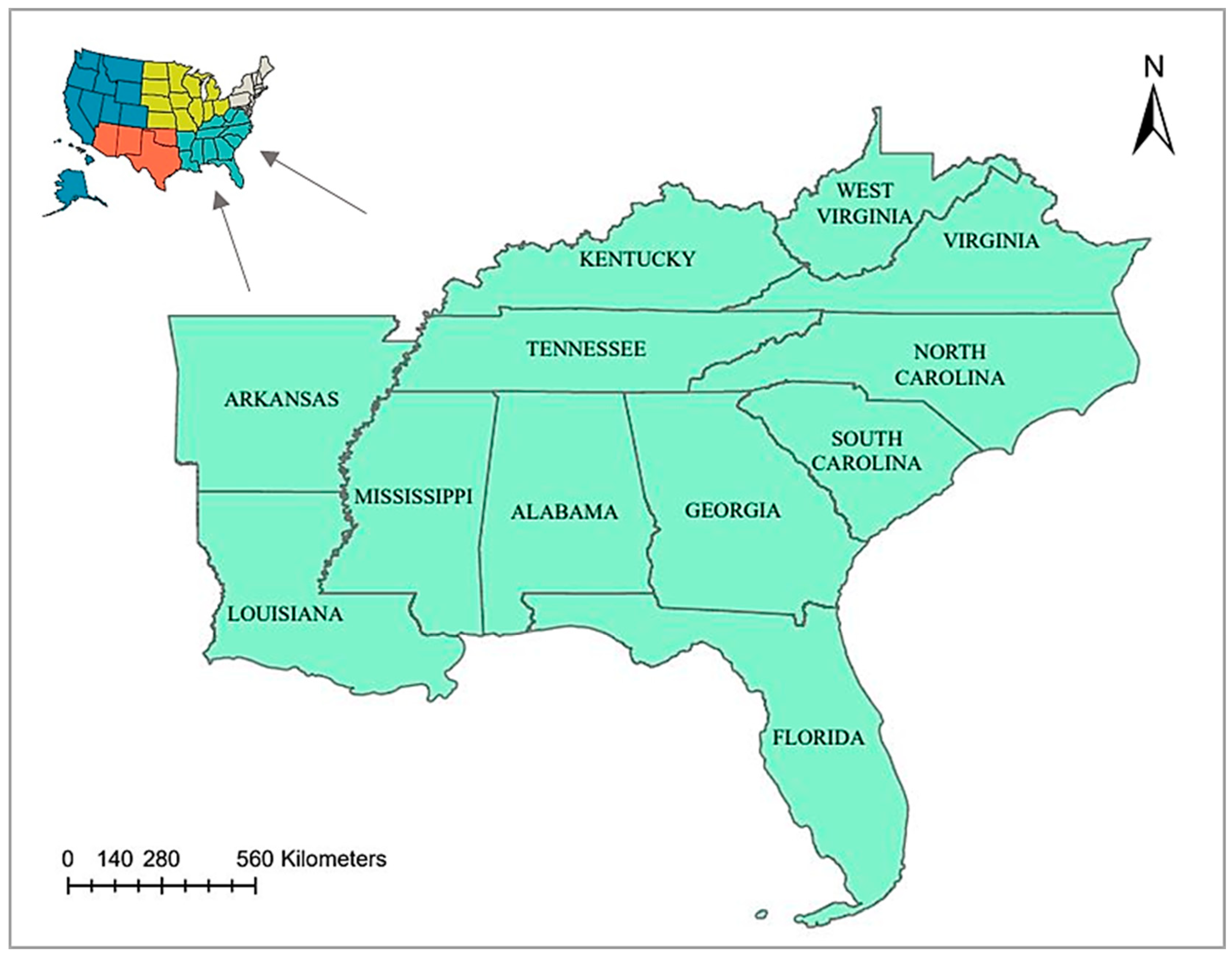
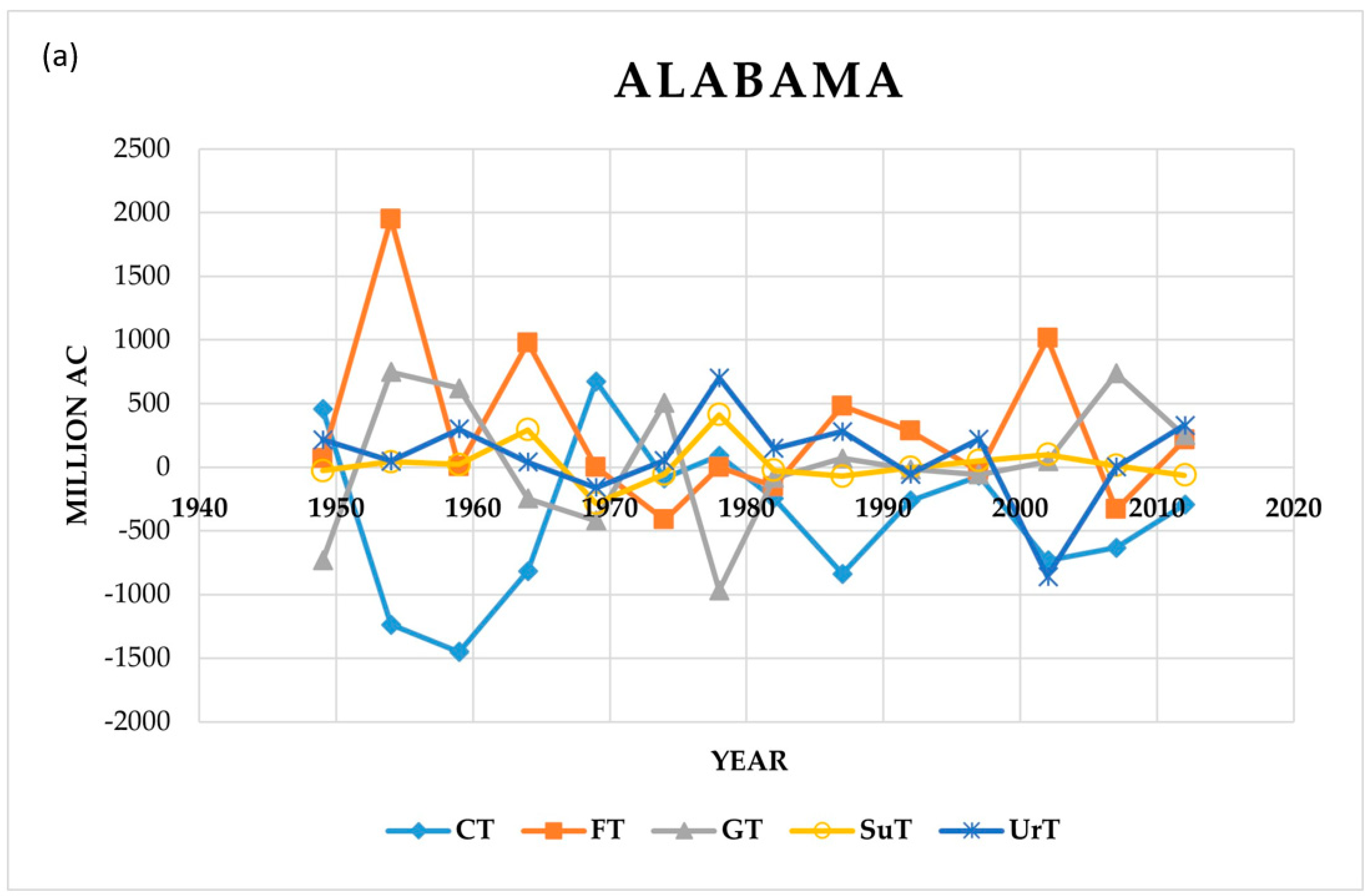
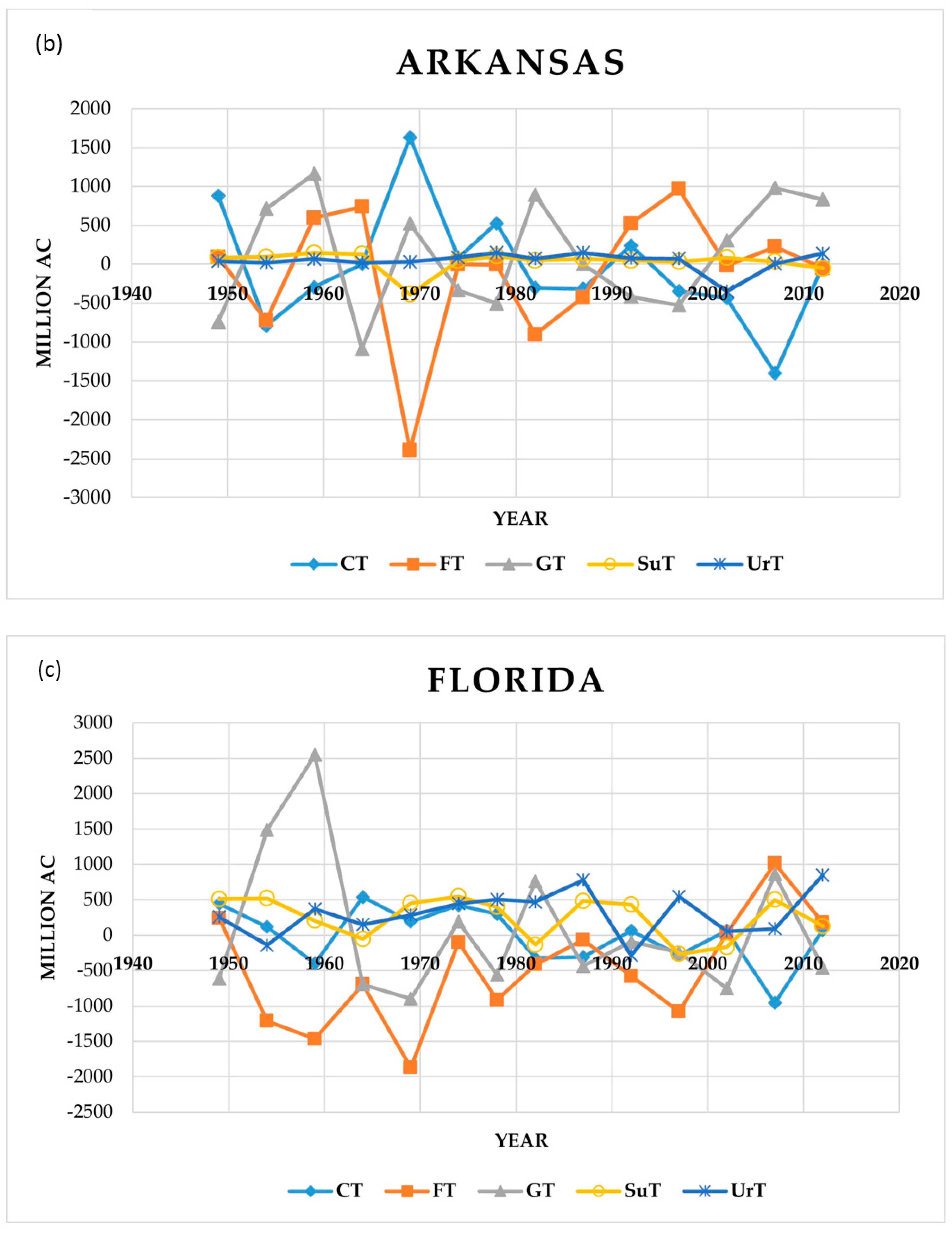
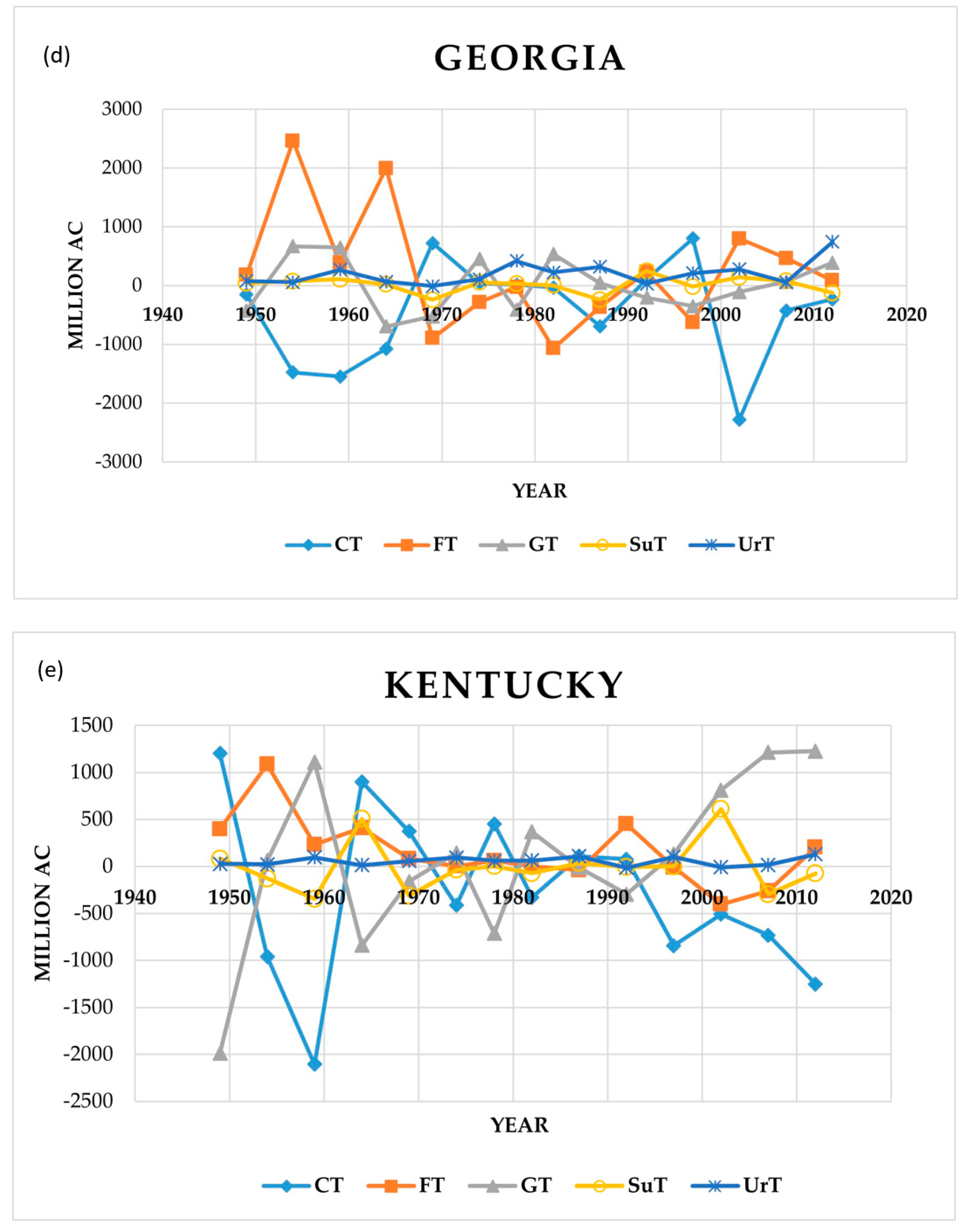
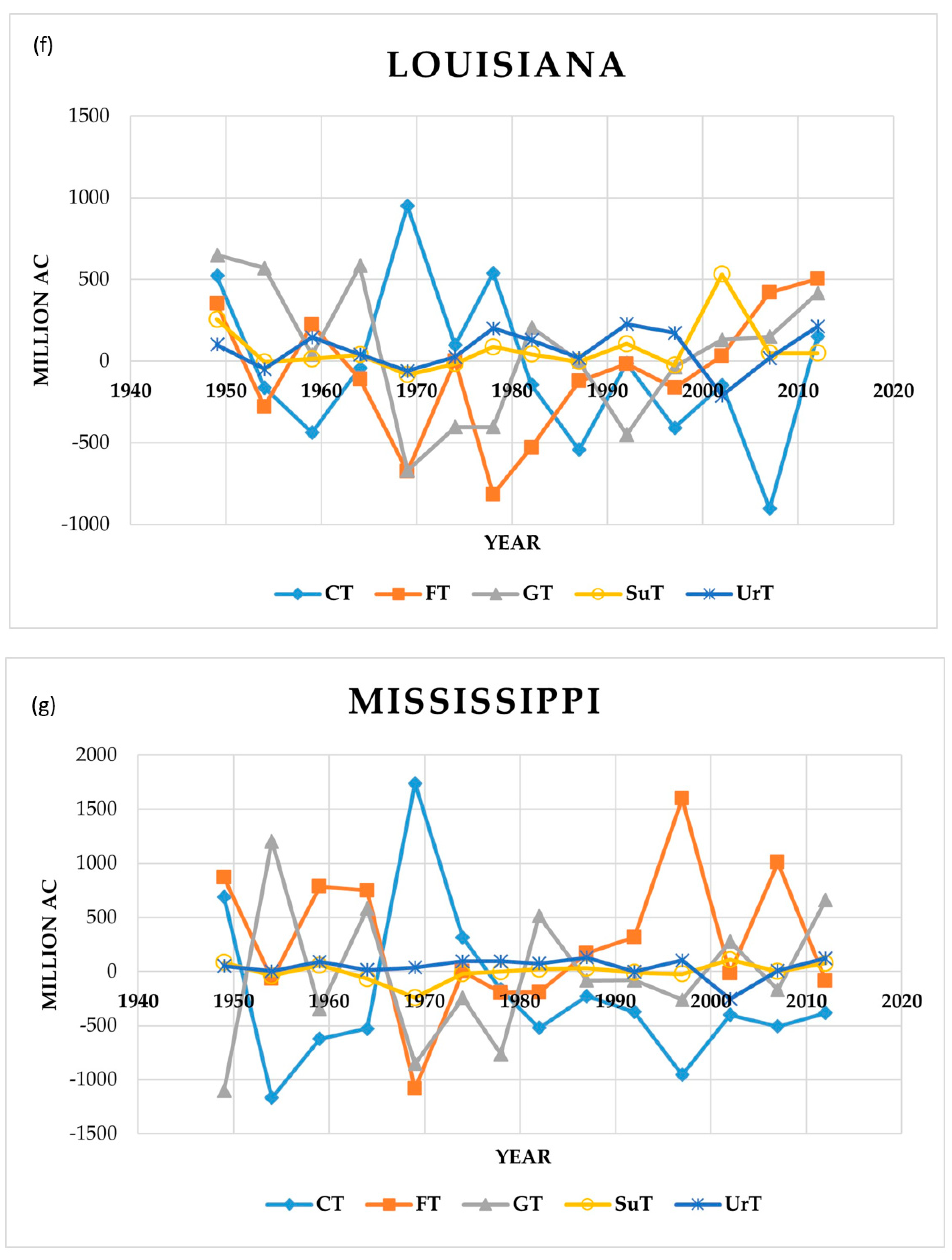
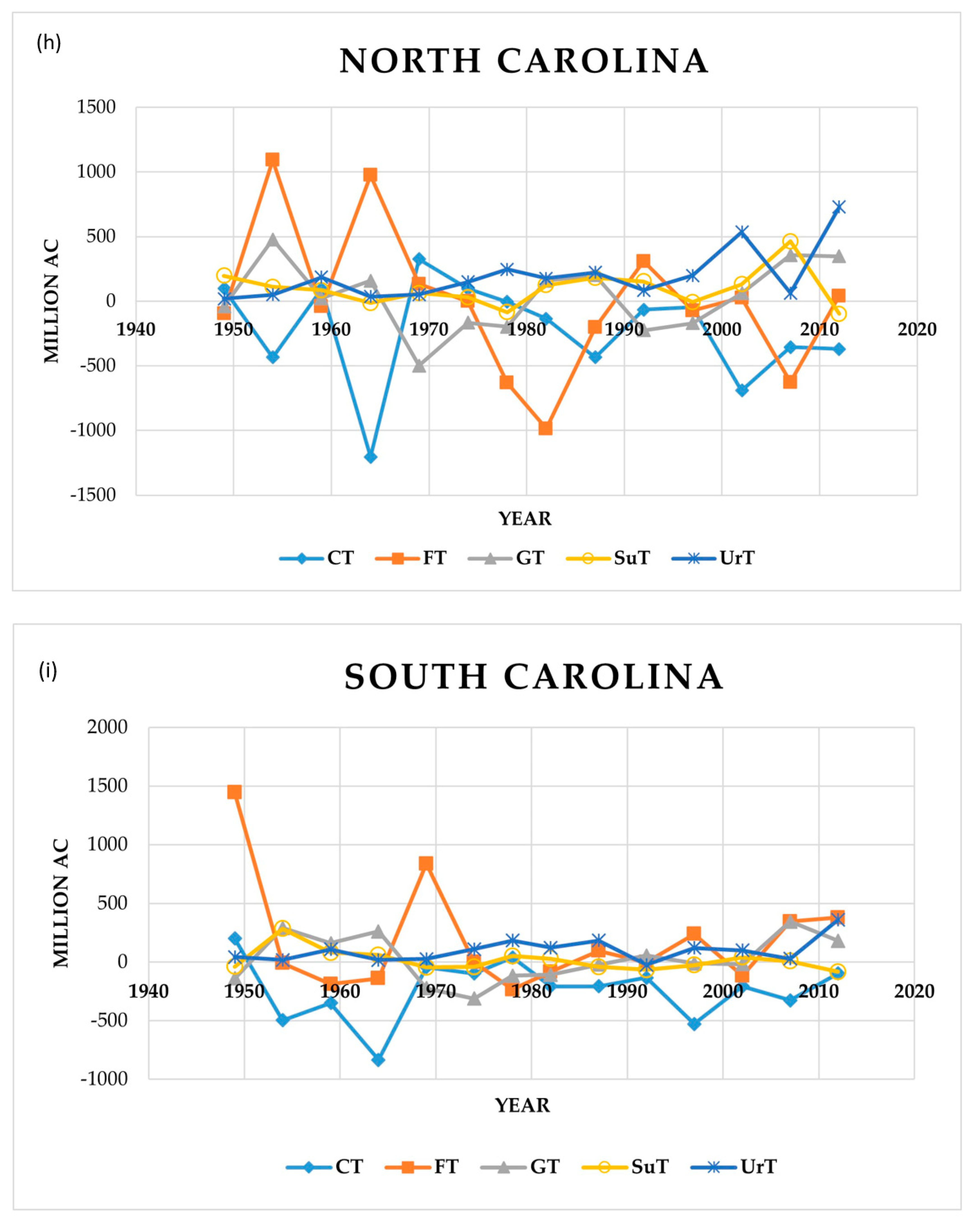
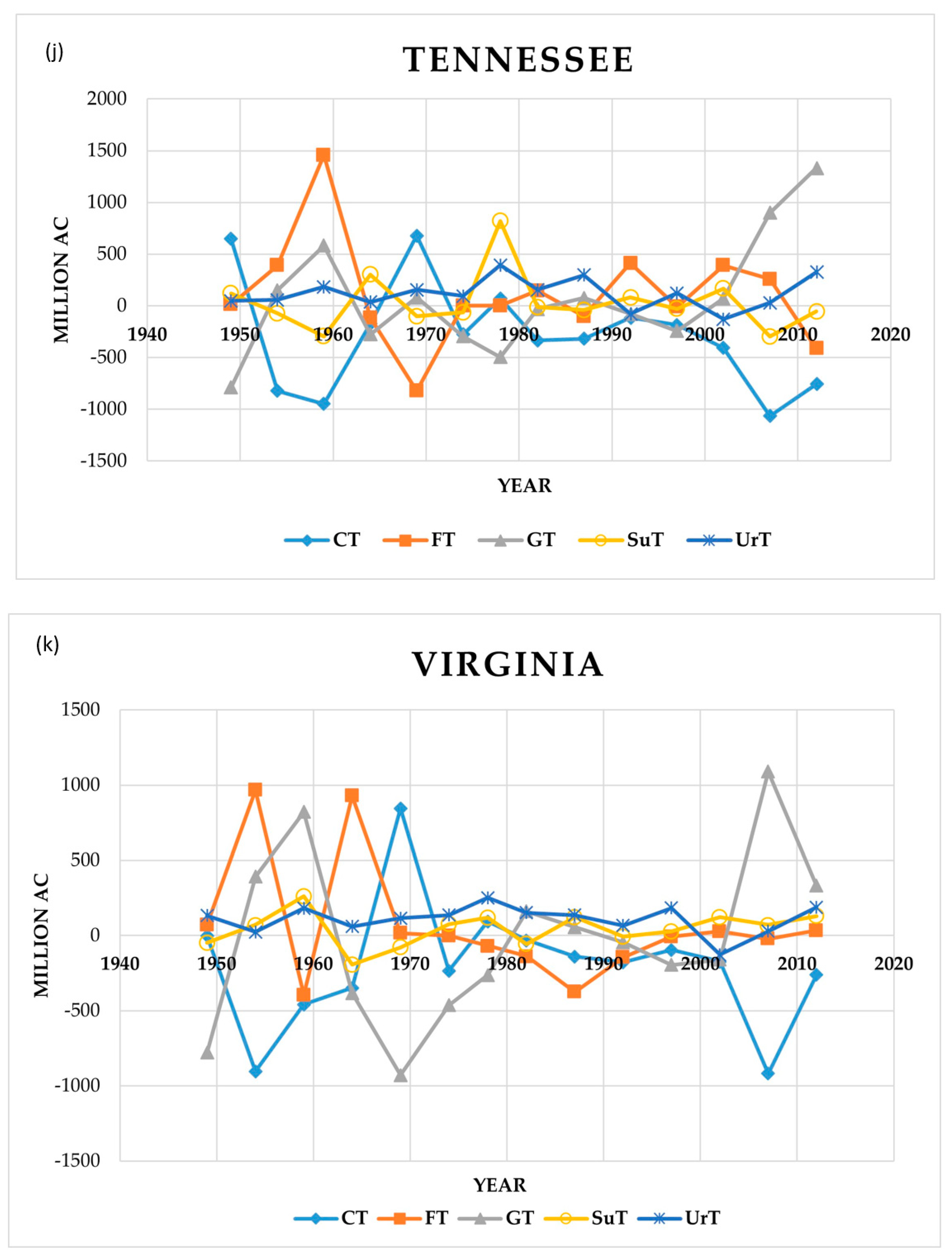
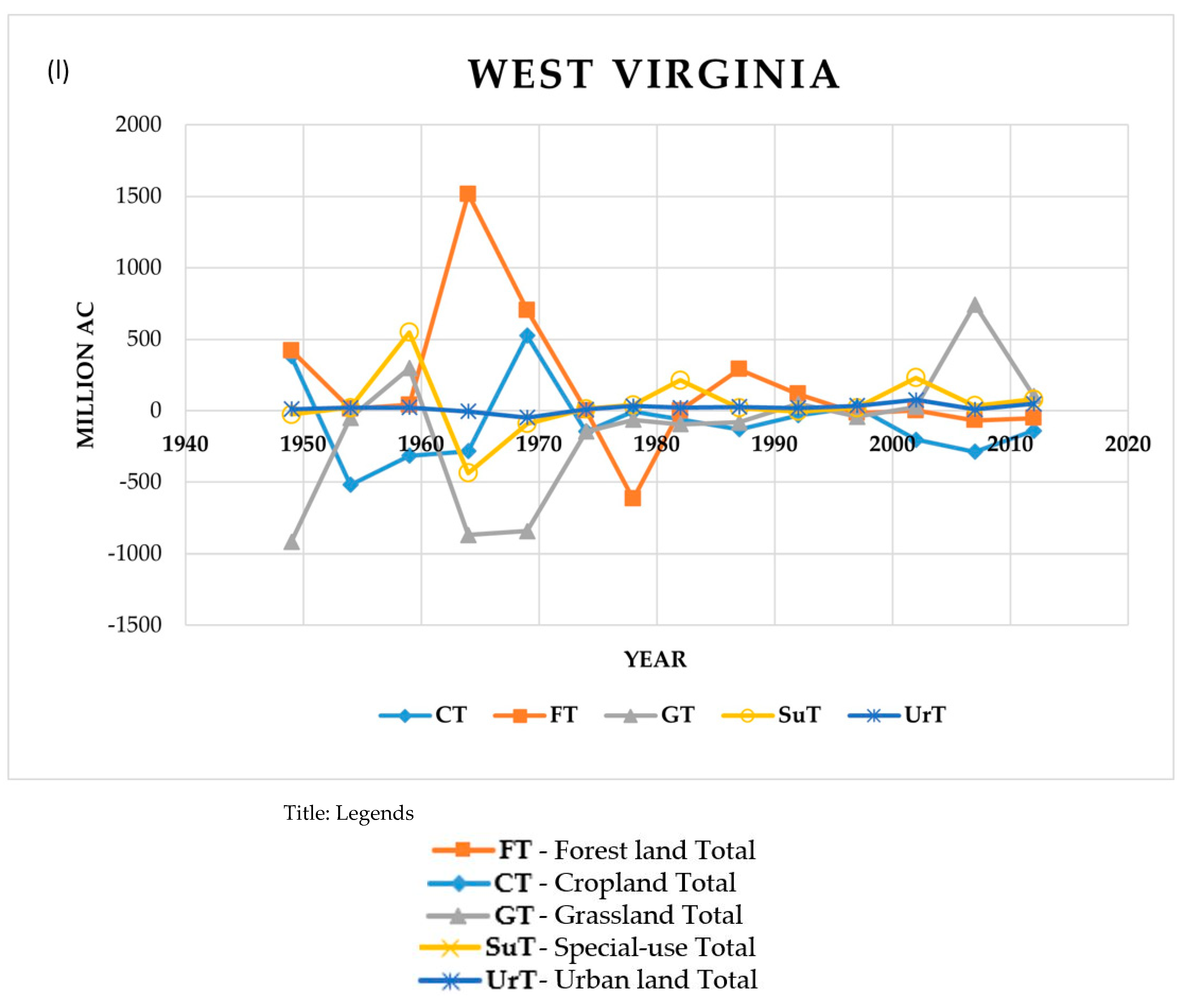
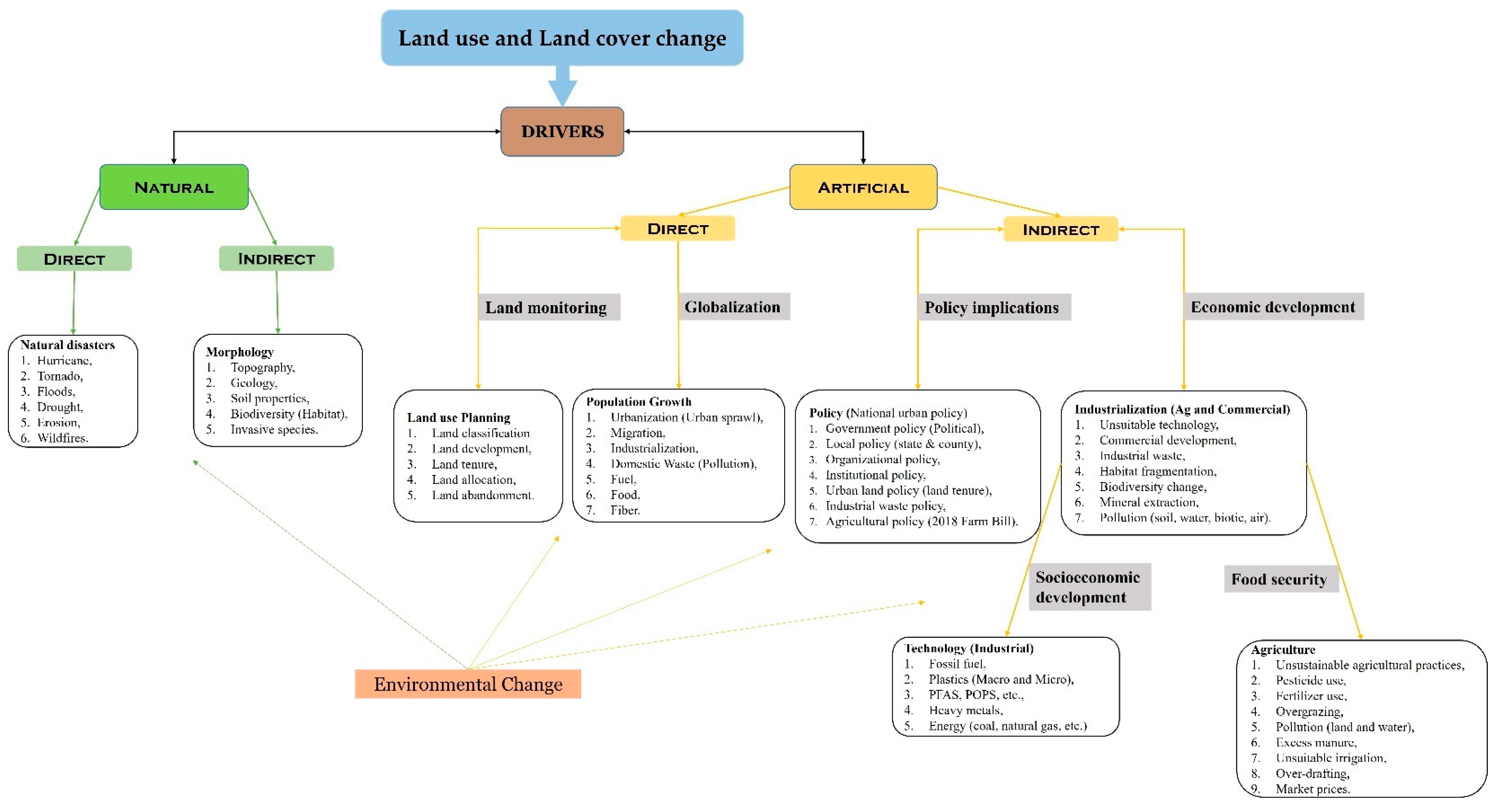
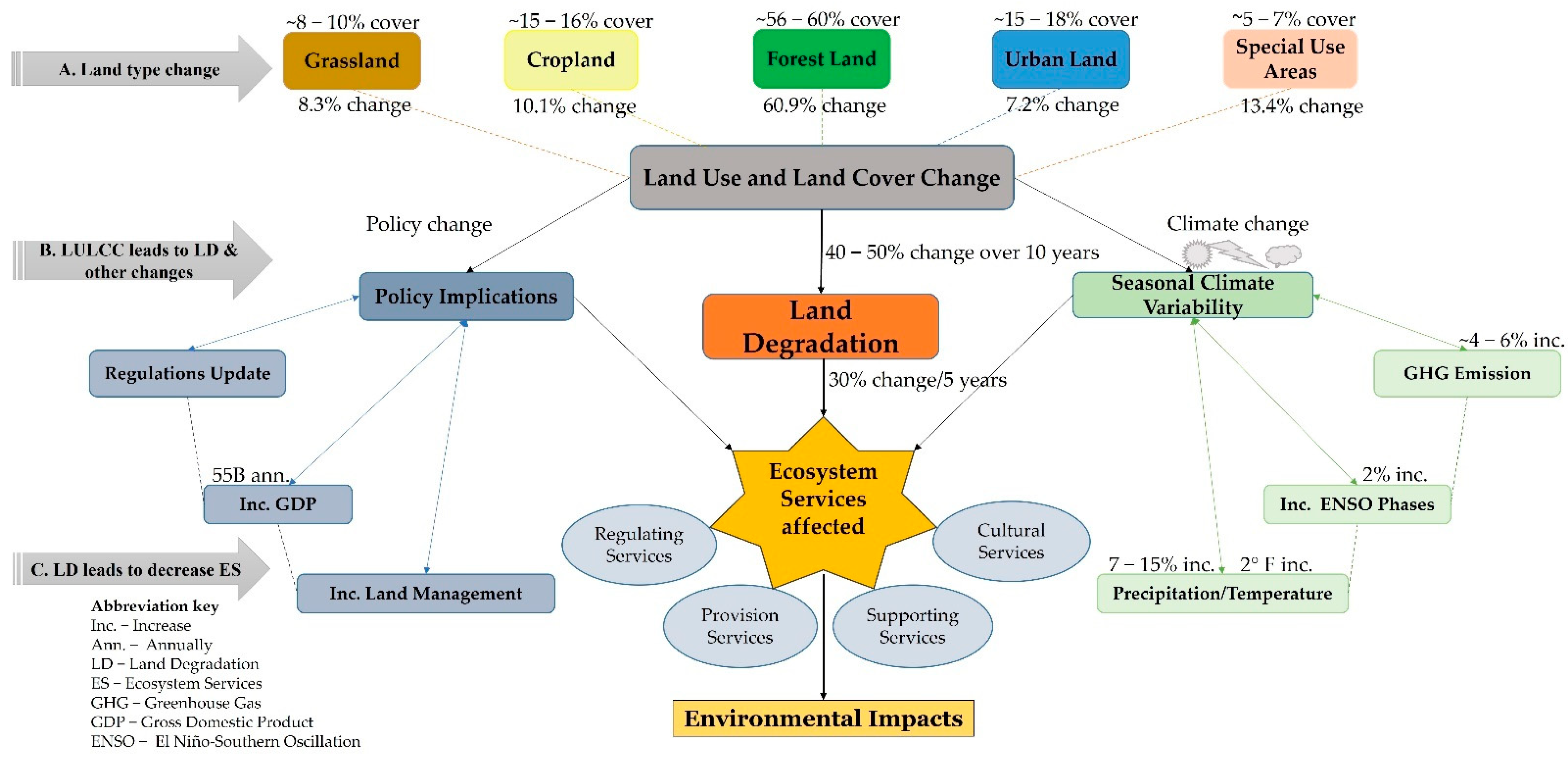
| Land Type | Categories | Explanation |
|---|---|---|
| Forest land | Definition | The forest use excludes forest land in parks, wildlife areas, and similar special-purpose uses from the U.S. Forest Service’s inventory of total forestland. |
| Forest land grazed | It mainly includes forest acres with grass or other forage growth. Forest forage growth consists of forest, brush-grown pasture, arid woodlands, etc. The total acreage of forested grazing land includes woodland pasture in farms plus estimates of forested grazing land not in farms. The data on active grazing is usually obtained from the Census of Agriculture, the NRI, and the U.S. Forest Service. | |
| Forest land not grazed | Forest-use land which is not used for grazing. | |
| Cropland | Definition | The combined data for cropland harvested, crop failure, and cultivated summer fallow is known as cropland used for crops, or the land used as an input to crop production. |
| Cropland harvested | Row crops and closely sown crops like Wheat, Soybean, Potato, Sugar beets, Canola, Corn, Cotton, Soybeans, etc.; Hay and silage crops like Rye, Oats, Alfalfa, Clover, Sorghum, etc.; Tree fruits, small fruits, berries, and tree nuts like Apple, Oranges, Almonds, Grapes, Blue berries, etc.; Vegetables and melons, e.g., Lettuce, Tomatoes, Potatoes, Cucumbers, Cantaloupe, watermelon; Miscellaneous other minor crops. Annual estimates of cropland harvested are based on (a) census data and, (b) the series provided by National Agricultural Statistics Service (NASS) on principal crops harvested | |
| Crop failure | As the name indicates, crop failure includes the acreage with failed crop. Extreme weather conditions, insect/diseases are the major reason for the crop failure but other reasons such as land not harvested due to lack of labor, low market prices, etc. Crop failure = cropland planted − Cropland harvested. Here, we do not include the crops which are not meant to be harvested (e.g., cover crops, green manure crops, other soil improvement crops, etc.). the acreage with such crop is included in crop idle. In recent years, crops have failed on 2–3% of the acreage planted for harvest. Annual estimates of crop failure have been calculated from the data provided by NASS. | |
| Cultivated summer fallow | The acreage with crop which is cultivated and kept for one or more seasons is considered as cultivated summer fallow. It is usually grown in the sub-humid regions of the west to stock up the moisture and control the weeds before planting the small grains. This practice is mandatory for dry cropland usually found in the west. crop production in the drier cropland areas of the West. We do not include the crop which is a soil improvement crop but not harvested and left idle. Since the late 1970s, Census of Agriculture and unpublished NASS data are the sources for Cultivated summer fellow. Before that it used to be calculated from various separate sources. | |
| Cropland pasture | Here, the cropland is used for pasture without any changes made or being harvested. If the acres are grazed before or after harvesting it is not considered as cropland pasture. Estimates were derived from the census of agriculture. | |
| Idle cropland | It includes the acres without any kind of plantation without the aim to be harvested at some point like cover crops or soil improvement crops. Various physical and economic reasons also play a part to make a cropland considered as idle. Land which comes under Federal farm program and not being used as cropland also falls under this category. Additionally, land included in USDA’s Conservation Reserve Program (CRP) and Wetlands Reserve Program (WRP) is considered as idle. | |
| Urban land | Definition | Urban area includes residential areas and concentrations of nonresidential urban areas, such as commercial, industrial, and institutional land; office areas; urban streets and roads; major airports; urban parks and recreational areas, and other land within urban-defined areas. |
| Census urban areas include densely populated areas with at least 50,000 people (“urbanized areas”) and densely populated areas with 2500 to 50,000 people (“urban clusters”) Densely populated areas-blocks with a population density of at least 1000 people per square mile, surrounding blocks with a density of at least 500 people per square mile, and “less densely settled blocks that form enclaves or indentations or are used to disconnect discontinuous areas with qualifying densities.” The Census Bureau collects and prepare the data for urban area every 10 years. Here, cities that are essentially rural in character are excluded. | ||
| Grassland and Pasture | Definition | All open land, regardless of the ownership, used primarily for pasture and grazing falls under this category. |
| It includes shrub and brush land types of pasture, grazing land with sagebrush and scattered mesquite, and all tame and native grasses, legumes, and other forage used for pasture or grazing. Usually, grassland pasture and range are not always clearly distinguish able from other types of pasture and range and they almost always overlap in transitional areas | ||
| Special Use Area | Definition | Land which is mainly used for miscellaneous purpose which bears farmsteads, roads, lanes, etc. is considered as special use land. |
| Rural transportation | It includes roads, railway lines in rural areas, highways, airports and all the various types of transportation methods outside of urban areas. | |
| Rural parks and wildlife areas | As the name indicates, this type of land includes wilderness areas including Federal and State parks. | |
| National defense and industrial areas | These are mainly used for military purpose which includes housing, airfields, R&D (Research and Development), etc. Such land is owned by Department of Defense and Department of Energy. |
| Data Types | Land Type | Data Set, Descriptions, and Link | Assessed | Last Update |
|---|---|---|---|---|
| Acreage | Forest land | Total forest-use land, 1945–2012, by State: Forest-use land grazed and forest-use land not grazed. | 8 December 2022 | 28 August 2017 |
| Cropland | Cropland, 1945–2012, by State: The sum of cropland used for crops, cropland idled, and cropland used for pasture. | |||
| Grassland | Grassland pasture and range, 1945–2012, by State: Grassland and other nonforested pasture and range in farms plus estimates of open or nonforested grazing land not in farms. Does not include cropland used for pasture or forest land grazed. | |||
| Special Use land | Total special uses, 1945–2012, by State: Rural transportation, rural parks and wildlife, defense and industrial, plus miscellaneous farm and other special uses. | |||
| Urban land | Urban area, 1945–2012, by State: Densely-populated areas with at least 50,000 people (urbanized areas) and densely-populated areas with 2500 to 50,000 people (urban clusters) |
Publisher’s Note: MDPI stays neutral with regard to jurisdictional claims in published maps and institutional affiliations. |
© 2022 by the authors. Licensee MDPI, Basel, Switzerland. This article is an open access article distributed under the terms and conditions of the Creative Commons Attribution (CC BY) license (https://creativecommons.org/licenses/by/4.0/).
Share and Cite
Nedd, R.; Anandhi, A. Land Use Changes in the Southeastern United States: Quantitative Changes, Drivers, and Expected Environmental Impacts. Land 2022, 11, 2246. https://doi.org/10.3390/land11122246
Nedd R, Anandhi A. Land Use Changes in the Southeastern United States: Quantitative Changes, Drivers, and Expected Environmental Impacts. Land. 2022; 11(12):2246. https://doi.org/10.3390/land11122246
Chicago/Turabian StyleNedd, Ryan, and Aavudai Anandhi. 2022. "Land Use Changes in the Southeastern United States: Quantitative Changes, Drivers, and Expected Environmental Impacts" Land 11, no. 12: 2246. https://doi.org/10.3390/land11122246
APA StyleNedd, R., & Anandhi, A. (2022). Land Use Changes in the Southeastern United States: Quantitative Changes, Drivers, and Expected Environmental Impacts. Land, 11(12), 2246. https://doi.org/10.3390/land11122246






